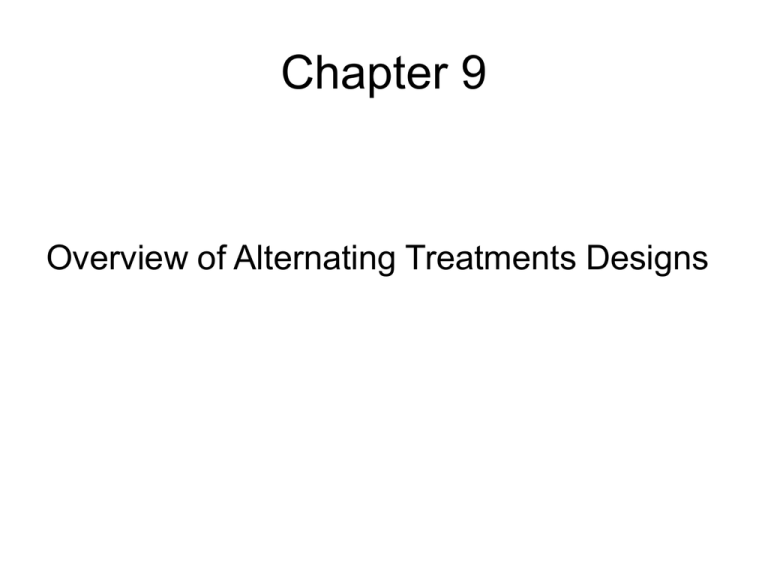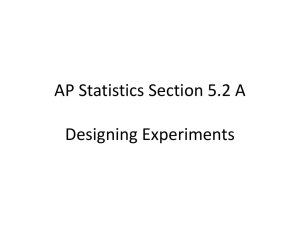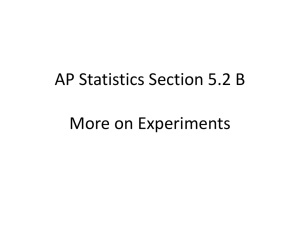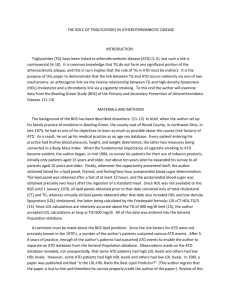Chapter 9
advertisement

Chapter 9 Overview of Alternating Treatments Designs Background/Overview • Alternating Treatments Designs (ATD) requires the “rapid alternation of two or more distinct treatments while their effects on a single target behavior are noted.” • ATD does not require the collection of baseline data. However, when possible it should be collected. Background/Overview • Two important points – The presentation of the treatments should be counterbalanced (presented the same number of times). – The subjects should be able to discriminate between or among the treatment conditions. Three types of ATD • Alternating treatments without baseline • Baseline followed by alternating treatments • Baseline followed by alternating treatments with a final treatment phase. Alternating Treatments w/o Baseline • This treatment can be implemented immediately. • This design should actually include a type of baseline data by having a no-treatment phase as one of the alternating treatments (Alternating treatments with a control condition design). Baseline Followed by ATD • Two situations when gathering a baseline should not continue. – When the nature of the target behavior is severely ethical (Self-abusive behaviors). – When the data trend is moving in a countertherapeutic direction. Baseline Followed by ATD • Four steps to follow: – Carefully define the independent and dependent variables. – Determine a schedule for counterbalancing the presentation of the treatments. – Collect baseline data for the dependent variable for a number of sessions (baseline phase does not have to be stable before introducing the treatment). – Introduce treatments in their predetermined order. Baseline Followed by ATD and a Final Treatment Phase • It is important to continue the most effective treatment. • Therefore, one would collect baseline, introduce alternating treatments, then continue the study using the most effective treatment. Prediction, Verification, and Replication • There are some concerns: • The determination of a functional relationship b/w the DV and the IV is weak compared to reversal and multiple baseline designs. • The possibility of multiple treatment interference might produce carryover effects that obscure the relationship of the DV to IV. • External Validity must be addressed by replicating with different subjects and/or conditions. Prediction, Verification, and Replication • Cooper et al. argued that ATD addresses each of the preceding issues: • Prediction: each data point serves as a predictor of future behavior under the same treatment. • Verification: Each successive data point serves to verify previous predictions of performance under the same treatment. • Replication: Successive data points replicates the differential effects produced by the other treatments. Prediction, Verification, and Replication • Neuman (1995) points out thatATD may have good internal validity for two reasons. • The patterns of response vary with the alternating treatment conditions, so there is minimal overlap among data in the conditions. • If one treatment is consistently associated with an improved level of responding, then the design demonstrates good experimental control. Important • The choice to use ATD, or any other design, should be based on a careful match of the dependent and the independent variables. Advantages of ATD • When you want to determine the relative effectiveness of more than one treatment on a given behavior. • When baseline data are either unavailable or unstable. • When the treatments are sufficiently different from each other. • When the subjects can discriminate the treatment conditions. • When the effects of sequencing the interventions might obscure the results. Disadvantages of ATD • When the treatments might interact and obscure results. • When the subjects cannot discriminate the treatment conditions. • When the treatments typically produce slow behavior changes. • When the treatments need to be administered over a continuous period of time to be effective. • When it becomes difficult to counterbalance the various aspects of the study. Adaptations of ATD • Simultaneous Treatment Design • This is rare in professional literature • Treatment conditions are presented at the same time. • Requires more skill, planning, and organization that the use of other designs. • It is difficult to systematically analyze the effects of several interventions presented at the same time. Adaptations of ATD • Adapted Alternating Treatments Design • Each intervention is applied to different behaviors that are considered to be of equal response difficulty but functionally independent. • The process of equating behaviors can be time consuming and problematic.











